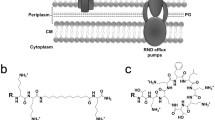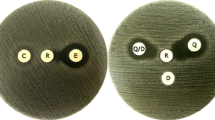Abstract
The efficacy of rifamycin SV and vancomycin againstBacteroides fragilis was compared with that of metronidazole in vitro and in vivo. The in vitro comparison was based on the MIC and on short-term growth curves, the in vivo comparison on a mixed infection withB. fragilis andEscherichia coli in a thigh infection model in mice.
Rifamycin SV was about 11 times less effective than metronidazole in vivo, according to dose, and about 30 times less effective according to the mean plasma concentration. This lower efficacy could have been anticipated on the basis of the effect on in vitro grwoth curves, but not from the MIC.
Vancomycin was about nine times less effective than metronidazole in vivo according to dose and about 18 times less effective according to the mean plasma concentration. The latter difference was less than would have been predicted from the results obtained in vitro, i.e., from both the effect on the growth curves and the MIC.
Similar content being viewed by others
Literature Cited
Amon I, Amon K, Hüller H (1978) Pharmacokinetics and therapeutic efficacy of metronidazole at different dosages. Int J Clin Pharmacol 16:384–386
Armitage P (1971) Statistical methods in medical research. Oxford: Blackwell, pp 444–450
Bergamini N, Fowst G (1965) Rifamycin SV. Arzneimittelforsch 15:951–1002
Dijkmans BAC, Mattie H, Hermans J, Van Furth R (1984) Quantification of the effect of anti-anaerobic drugs in experimentalBacteroides fragilis infection in mice. J Antimicrob Chemother 13:79–86
Finegold SM (1977) Anaerobic bacteria in human disease. New York: Academic Press, p 519
Kucers A (1982) Chloramfenicol, erythromycin, vancomycin, tetracylines. Lancet 1:425–429
Leading article (1973)Bacteroides in the blood. Lancet 2:27–28
Mattie H, Goslings WRO, Noach EL (1973) Cloxacillin and nafcillin: serum binding and its relationship to antibacterial effect in mice. J Infect Dis 128:170–177
Mattie H, Vaishnav J (1983) The effect of antimicrobial drugs on the growth kinetics ofBacteroides in vitro. Curr Microbiol 8:191–194
Ralph ED, Clarke JT, Libke RD, Luthy RP, Kirby WMM (1974) Pharmacokinetics of metronidazole as determined by bioassay. Antimicrob Agents Chemother 6:691–696
Sutter VL, Kwok YY, Finegold SM (1974) In vitro susceptibility testing of anaerobes: standardization of a single disc test. In: Anaerobic bacteria: role in disease. Springfield IL: CC Thomas
Tedesco F, Markham R, Gurwith M, Christie D, Bartlett JG (1978) Oral vancomycin for antibiotic-associated pseudomembranous colitis. Lancet 2:226–228
Author information
Authors and Affiliations
Rights and permissions
About this article
Cite this article
Dijkmans, B.A.C., Vaishnav-Nair, J. & Mattie, H. Efficacy of rifamycin SV and vancomycin againstBacteroides fragilis in vitro and in experimentally infected mice. Current Microbiology 12, 53–58 (1985). https://doi.org/10.1007/BF01567754
Issue Date:
DOI: https://doi.org/10.1007/BF01567754




